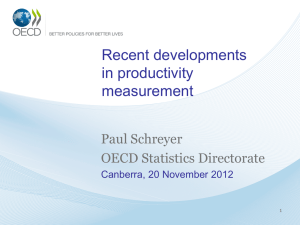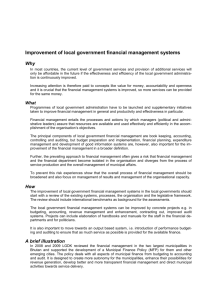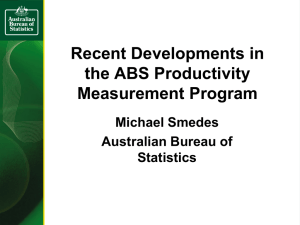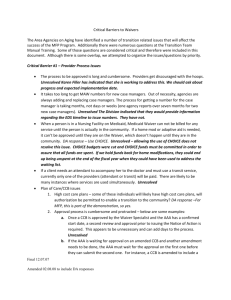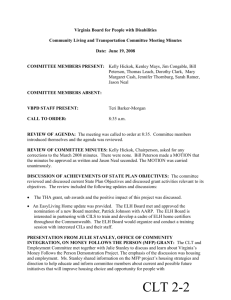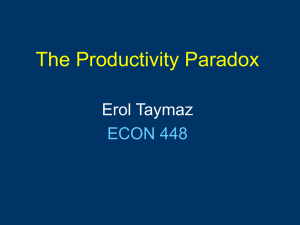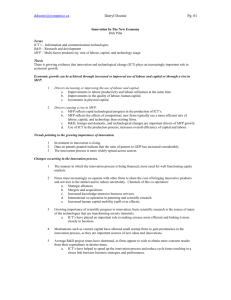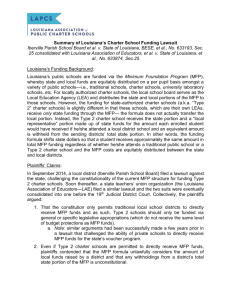A First Look at How MFP Participants Fare After Returning to the
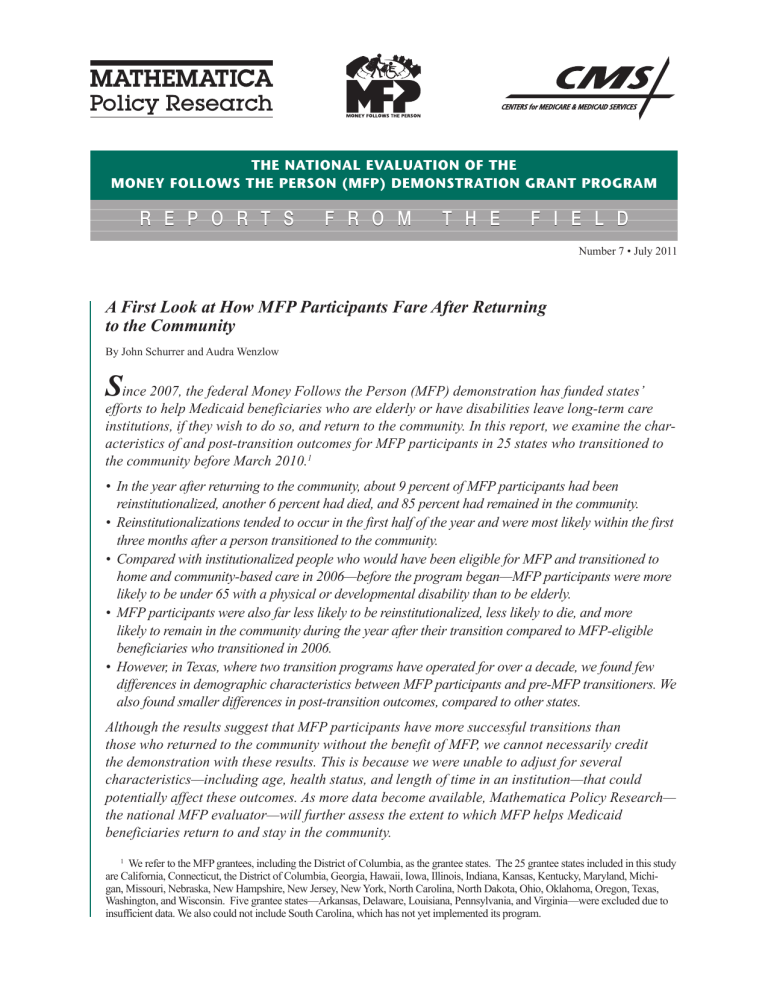
THE NATIONAL EVALUATION OF THE
MONEY FOLLOWS THE PERSON (MFP) DEMONSTRATION GRANT PROGRAM
R E P O R T S F R O M T H E F I E L D
Number 7 • July 2011
A First Look at How MFP Participants Fare After Returning to the Community
By John Schurrer and Audra Wenzlow
S ince 2007, the federal Money Follows the Person (MFP) demonstration has funded states’ efforts to help Medicaid beneficiaries who are elderly or have disabilities leave long-term care institutions, if they wish to do so, and return to the community. In this report, we examine the characteristics of and post-transition outcomes for MFP participants in 25 states who transitioned to the community before March 2010.
1
• In the year after returning to the community, about 9 percent of MFP participants had been
reinstitutionalized, another 6 percent had died, and 85 percent had remained in the community.
• Reinstitutionalizations tended to occur in the first half of the year and were most likely within the first
three months after a person transitioned to the community.
• Compared with institutionalized people who would have been eligible for MFP and transitioned to
home and community-based care in 2006—before the program began—MFP participants were more
likely to be under 65 with a physical or developmental disability than to be elderly.
• MFP participants were also far less likely to be reinstitutionalized, less likely to die, and more likely to remain in the community during the year after their transition compared to MFP-eligible
beneficiaries who transitioned in 2006.
• However, in Texas, where two transition programs have operated for over a decade, we found few
differences in demographic characteristics between MFP participants and pre-MFP transitioners. We also found smaller differences in post-transition outcomes, compared to other states.
Although the results suggest that MFP participants have more successful transitions than those who returned to the community without the benefit of MFP, we cannot necessarily credit
the demonstration with these results. This is because we were unable to adjust for several
characteristics—including age, health status, and length of time in an institution—that could
potentially affect these outcomes. As more data become available, Mathematica Policy Research—
the national MFP evaluator—will further assess the extent to which MFP helps Medicaid beneficiaries return to and stay in the community.
1 We refer to the MFP grantees, including the District of Columbia, as the grantee states. The 25 grantee states included in this study are California, Connecticut, the District of Columbia, Georgia, Hawaii, Iowa, Illinois, Indiana, Kansas, Kentucky, Maryland, Michi
gan, Missouri, Nebraska, New Hampshire, New Jersey, New York, North Carolina, North Dakota, Ohio, Oklahoma, Oregon, Texas,
Washington, and Wisconsin. Five grantee states—Arkansas, Delaware, Louisiana, Pennsylvania, and Virginia—were excluded due to insufficient data. We also could not include South Carolina, which has not yet implemented its program.
ABOUT THE MONEY FOLLOWS THE PERSON DEMONSTRATION
The MFP demonstration, first authorized by Congress as part of the Deficit Reduction Act of 2005 and then extended to 2016 by the 2010 Patient Protection and Affordable Care Act, is designed to shift Medicaid’s longterm care spending from institutional care to HCBS. Congress has now authorized up to $4 billion in federal funds to support a twofold effort by state Medicaid programs (1) to transition people living in nursing homes and other long-term care institutions to homes, apartments, or group homes of four or fewer residents and
(2) to change state policies so that Medicaid funds for long-term care services and supports can “follow the person” to the setting of his or her choice. MFP is administered by CMS, which initially awarded MFP grants to 30 states and the District of Columbia and awarded grants to another 13 states in February 2011. CMS contracted with Mathematica to conduct a comprehensive evaluation of the MFP demonstration and to report the outcomes to Congress.
2
INTRODUCTION
Starting in 2007, states receiving MFP grants began to help Medicaid beneficiaries relocate from institutions
—nursing homes, intermediate care facilities for people with mental retardation (ICFs-MR), and psychiatric facilities—to community settings as part of a larger effort to rebalance their long-term care systems. As an incentive to participate, grantee states receive enhanced federal matching funds for most home and communitybased services (HCBS) provided to MFP participants in the first year after they leave the institution. Grantees are required by federal statute to reinvest these funds in additional improvements to their long-term care sys
tems. Of particular interest to policymakers is whether people who transition under MFP are able to remain in the community and whether the extra coordination and enhanced services that many states provide to MFP participants lead to improved outcomes.
By the end of 2010, almost 12,000 people had transi
tioned from institutions to the community through MFP; for about half of these MFP participants, over a year had passed since their initial transitions (Denny-Brown et al. 2011). For this subgroup, we examined whether participants remained in the community during the first year after their initial transition. Successful transitions can be measured by how long participants reside in their homes, their quality of life, and the absence of poor outcomes such as hospitalization or reinstitutionaliza
tion. In this study, we explored how participants fared in terms of three mutually exclusive outcomes:
• Reinstitutionalized
(returned to a nursing home, hospital, or ICF-MR during the year and stayed for at least 30 days)
•
Died
(were not re-admitted to an institution for at least 30 days but died during the year) 2
•
Remained in the community
for the full year after transition 3
Although the characteristics of the initial group of
MFP participants may not reflect those of all MFP participants served to date, their outcomes and experi
ences provide insight into what happened during the first years of the demonstration and what might be expected as the program continues to grow and mature.
We also studied the characteristics of and post-transi
tion outcomes for MFP participants compared to those of Medicaid beneficiaries who returned to the commu
nity and used HCBS before MFP began. This com
parison sheds light on whether MFP is helping people remain in the community longer. However, we cannot assume that MFP is responsible for differences in the post-transition outcomes between these two groups.
To measure the true effects of MFP, we would need a comparison group that is similar to MFP participants in terms of several characteristics associated with post-transition outcomes, including health status, level of care needed, and time spent in an institution before the transition. Such data were not available for MFP participants at the time of this study. Nevertheless, our
2 Death should not necessarily be considered a poor out
come. Some participants may prefer to spend their final days in a community setting rather than in an institution.
3 In our analysis, participants who returned to an institu
tion for less than 30 days were considered to have remained in the community. In future work, we will assess the extent to which MFP participants returned to institutions for less than a month.
comparisons do provide early descriptive evidence of how MFP participants may differ from other people who leave institutions and the degree to which they are able to remain in their communities.
We first describe MFP participants in terms of whether they were reinstitutionalized, died, or remained in the community during the year after their initial transition. We then summarize differ
ences in the characteristics of and outcomes for MFP participants versus the comparison group, presenting results for three subgroups targeted by MFP—the elderly, people with physical disabilities, and people with developmental disabilities. We exclude Texas from our initial comparisons because this state had considerable experience transitioning people to the community under its own state-run programs. We then present similar pre-post comparisons for Texas to explore the potential effects of MFP in a state with an established transition program. Finally, we discuss our plan to measure the impact of MFP after more detailed program data become available. (More details on our analysis can be found in the “Data and
Methods” box at the end of this report.)
POST-TRANSITION OUTCOMES FOR MFP
PARTICIPANTS
Across the 25 grantee states, there were 4,746 elderly and disabled MFP participants who had moved from institutions to the community by March 2010 and for whom we had more than a year of post-transition outcome data.
4 Our sample only includes the elderly
(age 65 or older) and people under 65 with physical or developmental disabilities because almost all of the
MFP participants in our sample (98 percent) fell into these subgroups (Lipson and Williams 2011). (People with mental illness made up the remaining 2 percent.)
Most MFP participants (85 percent) stayed in the com
munity for the full year after their transition. About
9 percent were reinstitutionalized during the year, and
6 percent died (Figure 1). As would be expected, rein
stitutionalization and death were most common among the elderly. About 14 percent of the elderly returned to
4 We limited our sample to people with at least 13 months of post-transition data to enable us to (1) observe outcomes for a full year and (2) determine whether an institutional stay lasted at least 30 days for those reinstitutionalized at the end of the year.
40%
30%
20%
10%
0%
100%
90%
80%
70%
60%
50%
6.0
9.2
84.8
10.9
13.8
75.4
5.9
10.3
83.8
1.6
3.6
94.8
Total
(n = 4,746)
Elderly
(n = 1,344)
PD
(n = 1,923)
DD
(n = 1,479)
Remained in community throughout Reinstitutionalized Died, never reinstitutionalized
Source: Mathematica’s analysis of 2008–2011 MFP Program Participation Data Files for 25 MFP grantee states (excludes
Arkansas, Delaware, Louisiana, Pennsylvania, and Virginia due to insufficient data).
DD (developmental disability) = people who transitioned from an ICF-MR; elderly = people age 65 or older who transitioned from a nursing home; PD (physical disability) = people under age 65 who transitioned from a nursing home.
3
4 an institution, compared to 10 percent of people with physical disabilities and only 4 percent of those with developmental disabilities. Similarly, about 11 percent of the elderly died within the year, compared to only
6 percent of those with physical disabilities and 2 percent of those with developmental disabilities. The elderly were therefore least likely to stay in the community
(75 percent), whereas almost all of those with developmental disabilities (95 percent) remained in the community. About 84 percent of people with physical disabilities remained in the community.
Overall, MFP participants in our sample were enrolled in the program for just under 11 months (Table 1).
Those who died or returned to an institution varied considerably in the amount of time they spent in the community before reinstitutionalization or death, but the average was 5 months.
Reinstitutionalizations tended to happen within the first six months after transition and were most likely during the first three months. About 39 percent of the reinstitutionalized MFP participants returned to an institution within three months, and 64 percent returned within six months (Figure 2). We found no discernable pattern in the amount of time an MFP participant remained in the community before death.
PRE- AND POST-MFP COMPARISONS
We compared the characteristics of and outcomes for two groups: MFP participants and Medicaid beneficiaries who transitioned from institutions to the community before MFP began. To make these comparisons as meaningful as possible, we chose pre-MFP beneficiaries who (1) lived in grantee states; (2) had been institutionalized for six months or more, and thus would have been eligible for MFP had the program existed in 2006; 5 and (3) transitioned to the community and used Section 1915(c) waiver services or state-plan HCBS (not including hospice).
6 We obtained all information on the pre-MFP transitioners from the
2005–2007 Medicaid Analytic eXtract (MAX) data system. Because we could not adequately differentiate reinstitutionalizations that occur within one month of a transition in the MAX files, we limited both groups to people who lived in the community for at least
60 days following discharge from an institution. Our final sample contained 4,562 MFP participants and
12,849 pre-MFP transitioners across the 25 grantee states (data not shown).
5 Before the passage of the Patient Protection and Affordable Care Act (ACA) in March 2010, Medicaid beneficiaries were required to have 180 days of institutional care in order to be eligible for MFP. The ACA reduced the requirement to
90 days, not counting any days covered by Medicare’s skilled nursing-home benefit. We used the 180-day standard when selecting individuals for the comparison group because all
MFP participants in our analysis transitioned before the ACA was enacted.
6 Although hospice is a covered MFP service, states do not appear to target individuals for community-based endof-life care under MFP. Excluding hospice users from the comparison group helps to ensure we do not overstate death rates in the pre-MFP period.
TABLE 1. AVERAGE NUMBER OF MONTHS IN THE COMMUNITY BEFORE REINSTITUTIONALIZATION
OR DEATH, FOR ALL MFP PARTICIPANTS AND BY SUBGROUP
Characteristic
Number of MFP participants
Average number of months participating in MFP
(Standard deviation)
Total
4,746
10.9
(2.9)
Elderly
1,344
10.2
(3.5)
PD
1,923
10.8
(3.0)
DD
1,479
11.7
(1.6)
Number of participants who were reinstitutionalized
Average number of months in the community until reinstitutionalization
(Standard deviation)
436
4.7
(3.4)
185
4.7
(3.3)
198
4.6
(3.4)
53
5.3
(3.6)
Number of participants who died
Average number of months in the community until death
(Standard deviation)
284
5.1
(3.3)
146
4.9
(3.2)
114
5.0
(3.4)
24
6.4
(3.7)
Source: Mathematica’s analysis of 2008–2011 MFP Program Participation Data Files for 25 MFP grantee states (excludes
Arkansas, Delaware, Louisiana, Pennsylvania, and Virginia due to insufficient data).
DD (developmental disability) = people who transitioned from an ICF-MR; elderly = people age 65 or older who transitioned from a nursing home; PD (physical disability) = people under age 65 who transitioned from a nursing home.
Figure 2. Distribution of Months That MFP Participants Spent in the Community Before
Reinstitutionalization
15
10
5
0
3 6 9
Number of Months Until Reinstitutionalization
12
Source: Mathematica’s analysis of 2008–2011 MFP Program Participation Data Files for 25 MFP grantee states (excludes
Arkansas, Delaware, Louisiana, Pennsylvania, and Virginia due to insufficient data).
Among those who lived in the community for at least
60 days, Texas accounted for 2,027 (44 percent) of the
MFP participants and 1,268 (10 percent) of the ben
eficiaries who left institutions in 2006. Due to its size and history of running its own transition programs, we excluded Texas from our pre-post comparison to avoid distorting the results for the other states. Later in this report, we present separate pre-post comparisons for
Texas to explore the effects of MFP in a state with an established transition program.
All Grantee States Except Texas
In our first pre-post comparison (which excluded
Texas), we found that a large share of pre-MFP transi
tioners were elderly, while MFP participants tended to be younger people with disabilities. About 64 percent of those who transitioned in the pre-MFP period were elderly, compared with only 23 percent of the MFP population (Figure 3). On the other hand, people with physical disabilities made up only 26 percent of pre-
MFP transitioners but 47 percent of MFP participants.
Likewise, people with developmental disabilities repre
sented only 10 percent of pre-MFP transitioners but
30 percent of MFP participants.
Across all subgroups, the average age of MFP partici
pants was 55 years, compared with 69 in the pre-MFP period (Table 2). MFP participants were also more likely to be male (54 percent) compared to people who transitioned before MFP (35 percent). These differ
ences were primarily driven by large disparities in age and gender among elderly people. About 33 percent of the elderly MFP participants were male, compared with less than a quarter in the pre-MFP period. Similarly,
5
Figure 3. Distribution of (1) Pre-MFP Eligibles Who Transitioned to the Community and (2) MFP
Participants (excluding Texas)
Pre-MFP Transitioners (2006) MFP Participants (2008−2010)
DD 10%
DD 30%
Elderly 23%
PD 26%
Elderly 64%
PD 47% n = 11,581 n = 2,535
Sources: Mathematica’s analysis of the 2005–2007 MAX files and the 2008–2011 MFP Program Participation Data Files for 24
MFP grantee states (besides Texas, these numbers also exclude Arkansas, Delaware, Louisiana, Pennsylvania, and Virginia due to insufficient data).
DD (developmental disability) = people who transitioned from an ICF-MR; elderly = people age 65 or older who transitioned from a nursing home; PD (physical disability) = people under age 65 who transitioned from a nursing home.
6
TABLE 2. DEMOGRAPHIC CHARACTERISTICS OF (1) PRE-MFP ELIGIBLES WHO TRANSITIONED TO
THE COMMUNITY AND (2) MFP PARTICIPANTS (EXCLUDING TEXAS)
Characteristic
Number
Gender (percentage)
Total Elderly
Pre-MFP MFP Pre-MFP
PD DD
MFP Pre-MFP MFP Pre-MFP MFP
11,581 2,535 7,385 578 3,068 1,185 1,128 772
Male
Female
Average age at initial transition
Age at initial transition
(percentage)
Under age 21
21-44
45-64
65-74
75-84
34.9
65.1
69.3
1.7
10.5
23.5
14.5
24.0
53.7
46.3
54.8
1.9
22.6
50.3
12.0
8.7
24.3
75.7
81.8
n.a.
n.a.
n.a.
22.1
37.6
33.4
66.6
77.0
n.a.
n.a.
51.3
48.7
49.1
3.7
23.1
n.a.
73.1
44.3
n.a.
36.2
n.a.
55.8
44.2
50.0
1.4
23.7
74.9
n.a.
n.a.
3
59.8
40.2
42.5
7.4
44.9
3 42.2
4.3
0.8
65.8
34.2
45.6
3 4.0
38.0
50.1
3 6.2
3 1.4
85 or older 25.8
4.5
40.3
19.6
n.a.
n.a.
0.4
3 0.3
Sources: Mathematica’s analysis of the 2005–2007 MAX files and the 2008–2011 MFP Program Participation Data Files for 24
MFP grantee states (besides Texas, these numbers also exclude Arkansas, Delaware, Louisiana, Pennsylvania, and Virginia due to insufficient data).
DD (developmental disability) = people who transitioned from an ICF-MR; elderly = people age 65 or older who transitioned from a nursing home; PD (physical disability) = people under age 65 who transitioned from a nursing home.
the average age of an elderly MFP participant was 77, compared with 82 for pre-MFP transitioners. On the other hand, MFP participants with developmental dis
abilities were somewhat older, on average, than their pre-MFP counterparts. However, they made up only
10 percent of the pre-MFP transitions and therefore had only a small impact on the overall average age.
Overall and within each subgroup, reinstitutionalization and death rates were far lower among MFP participants than among their pre-MFP counterparts (Figure 4). About
6 percent of MFP participants were reinstitutionalized, compared with 22 percent of those who transitioned before MFP began. Likewise, the overall death rate was
5 percent among MFP participants versus 22 percent among pre-MFP transitioners.
7
These pre-post differences
7
When we add Texas to this analysis, we find that
7 percent of those who move to the community for at least
60 days were reinstitutionalized, about 5 percent died, and
88 percent stayed in the community for the rest of the year
(data not shown).
were especially obvious among the elderly—only
8 percent of elderly MFP participants were reinstitutional
ized compared with 26 percent in the pre-MFP period, and only 10 percent of elderly MFP participants died compared with about 32 percent of the pre-MFP elderly.
The sizable share of elderly in the pre-MFP group seems to account for much of the difference in the overall rates.
In all grantee states but Texas, about 90 percent of
MFP participants—but only 56 percent of pre-MFP transitioners—remained in the community for a full year. Among MFP participants, 82 percent of elderly,
90 percent of people with physical disabilities, and
96 percent of people with developmental disabilities remained in the community, compared to only 43 percent,
73 percent, and 92 percent in the pre-MFP period, respectively. Again, we cannot assume that MFP is responsible for these differences because we were unable to control for possible disparities in health, level of care needed, and other characteristics among MFP participants and pre-MFP transitioners.
Figure 4. Outcomes for (1) Pre-MFP Eligibles Who Transitioned to the Community and (2) MFP
Participants (excluding Texas)
90%
22.4
4.9
5.5
31.5
10.2
8.0
8.0
18.6
4.2
6.3
1.5
6.4
1.8
2.5
70%
21.8
50%
84.8
89.6
25.5
75.4
81.8
73.4
83.8
89.5
92.1
94.8
95.7
30%
55.8
43.0
10%
Total Total
Pre-MFP MFP
(n = 11,581) (n = 2,535)
Elderly Elderly
Pre-MFP MFP
(n = 7,385) (n = 578)
PD PD
Pre-MFP MFP
(n = 3,068) (n = 1,185)
DD DD
Pre-MFP MFP
(n = 1,128) (n = 772)
Remained in community throughout Reinstitutionalized Died, never reinstitutionalized
Sources: Mathematica’s analysis of the 2005–2007 MAX files and the 2008–2011 MFP Program Participation Data Files for 24
MFP grantee states (besides Texas, these numbers also exclude Arkansas, Delaware, Louisiana, Pennsylvania, and Virginia due to insufficient data).
DD (developmental disability) = people who transitioned from an ICF-MR; elderly = people age 65 or older who transitioned from a nursing home; PD (physical disability) = people under age 65 who transitioned from a nursing home.
7
8
Texas
As mentioned previously, we excluded Texas from our first analysis because of its considerable experience implementing its own transition programs: the Texas
Money Follows the Person program and the Promot
ing Independence Plan. The Texas Money Follows the
Person program—which preceded the federal MFP demonstration—helped over 13,000 people transi
tion from nursing homes between September 1, 2001, and June 1, 2007. The Promoting Independence Plan helped transition over 1,800 people with disabilities from state-supported living centers and ICFs-MR dur
ing the same period (Texas Health and Human Services
Commission et al. 2009). Implementing these state-run programs gave Texas a unique opportunity to address many of the outreach, staffing, and coordination chal
lenges later experienced by other grantee states while implementing their MFP programs (Denny-Brown and
Lipson 2009). Given Texas’s background, the period before the implementation of the national MFP demon
stration is better described as pre-expansion rather than pre-implementation.
Texas differed from other states in terms of the people who transitioned under its programs. In Texas, the demographic composition of people who returned to the community was nearly identical in the pre- and post-MFP periods (Figure 5). For example, MFP par
ticipants were almost the same age (56 years) as those who transitioned before MFP (55 years) (data not shown).
Likewise, transition outcomes for MFP participants and pre-MFP transitioners were much more similar in
Texas than in other states. About 87 percent of MFP participants in Texas remained in the community for a full year, compared with 80 percent in the pre-MFP period (Figure 6). In contrast, about 90 percent of the
MFP participants and 56 percent of the pre-MFP transi
tioners remained in the community in the other states.
As in other states, Texas’s largest difference between the pre- and post-MFP periods was among the elderly: more than 79 percent of the MFP elderly—but only
65 percent of the pre-MFP elderly—remained in the community. Among those with physical and devel
-
Figure 5. Distribution of (1) Pre-MFP Eligibles Who Transitioned to the Community and (2) MFP
Participants, in Texas and in Other Grantee States
9.7
90%
28.8
33.9
30.5
26.5
70%
50%
34.4
32.4
46.7
30%
36.8
33.7
63.8
10%
0%
0
22.8
Texas
Pre-MFP
(n = 1,268)
Texas
MFP
(n = 2,027)
Other Grantees Other Grantees
Pre-MFP MFP
(n = 11,581) (n = 2,535)
Elderly PD DD
Sources: Mathematica’s analysis of the 2005–2007 MAX files and the 2008–2011 MFP Program Participation Data Files for 25
MFP grantee states (excludes Arkansas, Delaware, Louisiana, Pennsylvania, and Virginia due to insufficient data).
DD (developmental disability) = people who transitioned from an ICF-MR; elderly = people age 65 or older who transitioned from a nursing home; PD (physical disability) = people under age 65 who transitioned from a nursing home.
Figure 6. Outcomes for (1) Pre-MFP Eligibles Who Transitioned to the Community and (2) MFP
Participants, in Texas
90%
6.3
14.1
4.7
8.7
11.3
8.1
12.9
5.7
13.1
5.3
10.7
2.5
0.5
0.9
2.8
24.2
70%
79.6
86.5
50%
40%
40
30%
20%
20
10%
36.8
0% 0
Total Total
Pre-MFP MFP
(n = 1,268) (n = 2,027)
64.5
33.7
79.1
81.2
63.8
84.0
Elderly Elderly
Pre-MFP MFP
(n = 467) (n = 683)
PD PD
Pre-MFP MFP
(n = 436) (n = 656)
97.0
22.8
96.4
DD DD
Pre-MFP MFP
(n = 365) (n = 688)
Remained in community throughout Reinstitutionalized Died, never reinstitutionalized
Sources: Mathematica’s analysis of the 2005–2007 MAX files and the 2008–2011 MFP Program Participation Data Files for Texas.
DD (developmental disability) = people who transitioned from an ICF-MR; elderly = people age 65 or older who transitioned from a nursing home; PD (physical disability) = people under age 65 who transitioned from a nursing home.
opmental disabilities, about the same percentage remained in the community before and after MFP began. The post-transition outcomes in Texas over time provide some clues as to what we might see in other states as transition programs expand and become more established.
STUDY LIMITATIONS
Although our analysis sheds some light on the rela
tionship between MFP and participant outcomes, four important limitations prevent us from drawing firm conclusions about the program’s true effects on posttransition outcomes. First, our comparison group—the pre-MFP eligibles who transitioned to the commu
nity—may differ from MFP participants in ways that we could not account for due to data limitations. These differences may include health status, length of time spent in an institution before transitioning, and level of care needed. For example, some MFP participants may have been unable to transition without the assistance offered by MFP, while this obviously would not have been the case for pre-MFP transitioners. This may have led to a mix of individuals who transitioned under MFP that significantly differs from those who transitioned before the program. Our analysis was also constrained by the information common to both MFP participant files and MAX data files—state, gender, institutional facility, and age. Due to the small sample of people who had completed their MFP participation at the time of this study, we were unable to refine the analysis by restricting the comparison group to only those who statistically matched to MFP participants.
Second, the death and reinstitutionalization rates reported in our comparative analysis may differ some
what from the true rates for both MFP participants and pre-MFP eligibles. To account for missing claims, we could only compare reinstitutionalization and death rates for people who successfully remained in the community for at least 60 days. If these rates differed between the MFP and pre-MFP groups before the
60-day mark, our results will not accurately reflect the overall differences in post-transition outcomes. Also,
9
10
MFP participants may include some people receiving hospice care, whereas we excluded pre-MFP eligibles receiving hospice at the time of their transition.
Third, we derived our outcomes data from different sources, using claims data for the pre-MFP transition
ers and program data for the MFP participants. These two data sets may differ in completeness or accuracy.
For example, the MFP program data may underreport reinstitutionalizations and mortality, in which case true differences between MFP participants and the compari
son group may be overstated.
The fourth limitation is one shared by all pre-post anal
yses: other changes may be occurring during the “pre” and “post” periods that affect the outcomes. In this study, such changes may include nursing home or ICF-
MR closures, changes in state policy affecting Medic
aid HCBS benefits, and changes in the availability of other support services (including subsidized housing).
These changes could affect the number of transi
tions and the types of people able to transition. More robust methods (for example, difference-in-difference methods) could be used to ameliorate this problem, but they would require data on people who transitioned after MFP’s implementation but did not participate in the program. In future reports, when more Medicaid data are available, we will be able to use such methods to better assess the effects of MFP on the people who transition and their post-transition outcomes.
DISCUSSION AND NEXT STEPS
Our findings suggest that, if MFP participants re-enter an institution, they are most likely to do so within the first three to six months after transitioning to the community. It is during this time that many states also shift the responsibility of coordinating MFP services from transition experts to care coordinators. States should consider how to make this process as smooth as possible to ensure continuity of care, especially during participants’ first, most vulnerable months in the community.
Our analysis also suggests that, compared to Medicaid beneficiaries who transitioned to the community and used HCBS before MFP began, MFP participants are younger and have lower rates of reinstitutionalization and death. Our separate analysis of the national MFP program in Texas—a state with a long history of running transition programs—indicates that these differences are at least partly due to the types of people transitioned by grantees during the initial years of the program. In
Texas, where MFP participants and pre-MFP transition
ers are similar in age, sex, and type of disability, we do not see such large differences between the two groups in rates of reinstitutionalization and death. The types of people each state was able to transition may reflect the outreach, staffing, and coordination challenges encoun
tered by states—or alternatively, the way in which states targeted their program to certain types of candidates.
Despite the overall similarity between the pre- and post-MFP groups in Texas, we did find small differ
ences in their post-transition outcomes. These differ
ences may reflect program effects associated with MFP administrative supports, such as additional funding for dedicated program staff. (It is unlikely that the differ
ences were caused by MFP supplementary services, as
Texas provides relatively few of these services com
pared to other grantee states.) More research is needed to assess whether these are true impacts of MFP and how they might vary across states with new versus established programs.
With additional claims data, as well as information on functional limitations from the Minimum Data Set, we will be better able to identify appropriate comparison groups for people enrolled in MFP. We will also be bet
ter able to assess the demonstration’s impact on a broad range of outcomes, including rates of transition to the community, reinstitutionalizations, deaths, and prevent
able hospitalizations (Brown et al. 2008).
This initial glimpse at the outcomes of MFP par
ticipants shows that states vary substantially in the populations they reach with demonstration services, which may have important implications for measuring program impacts and system transformation. As more data become available on both MFP participants and people who transitioned without MFP’s support, we hope to better understand whether and for whom MFP is improving long-term care options and outcomes.
ACKNOWLEDGMENTS
This research was conducted by Mathematica under contract with the Centers for Medicare & Medicaid
Services (CMS) (HHSM-500-2005-00025(0002)). The authors wish to thank Randall Brown, Carol Irvin,
Debra Lipson, and Bob Schmitz at Mathematica and
MaryBeth Ribar at CMS for their insightful comments on earlier drafts. Thanks also go to Dean Miller,
Gregory Bee, and Adrienne Martz for programming assistance and to Deirdre Sheean for graphic design.
REFERENCES
Brown, Randall, Carol Irvin, Debra Lipson, Sam
Simon, and Audra Wenzlow. “Research Design Report for the Evaluation of the Money Follows the Person
(MFP) Grant Program.” Cambridge, MA: Mathematica
Policy Research, October 3, 2008. Available at http://www.mathematica-mpr.com/publications/PDFs/
MFP_designrpt.pdf.
Denny-Brown, Noelle, and Debra Lipson. “Early
Implementation Experiences of State MFP Programs.”
National Evaluation of the Money Follows the Person
Demonstration Program, Reports from the Field,
No. 3. Cambridge, MA: Mathematica Policy Research,
November 2009. Available at http://www.mathematica-mpr.com/publications/PDFs/ health/MFPfieldrpt3.pdf.
Denny-Brown, Noelle, Debra Lipson, Christal Stone, and Jessica Ross. “Money Follows the Person Dem
onstration: Overview of State Grantee Progress,
July–December 2010.” Cambridge, MA: Mathematica
Policy Research, May 2011. Available at http://www.mathematica-mpr.com/publications/PDFs/ health/MFP_July-Dec2010_progress.pdf.
Lipson, Debra, and Susan Williams. “Money Follows the Person Demonstration Program: A Profile of Par
ticipants.” National Evaluation of the Money Follows the Person Demonstration Program, Reports from the
Field, No. 5. Cambridge, MA: Mathematica Policy
Research, January 2011. Available at http://www.mathematica-mpr.com/publications/PDFs/ health/mfpfieldrpt5.pdf.
Texas Health and Human Services Commission, Texas
Department of Aging and Disability Services, and
Texas Department of State Health Services. “The Texas
Money Follows the Person Operational Protocol.”
November 2009. Available at http://www.dads.state.tx.us/providers/pi/ mfp_demonstration/operationalprotocol/ operational-protocol.pdf. Accessed May 2, 2011.
11
12
DATA AND METHODS
Data Sources
For the MFP participants, we derived information on gender, age, institutional setting, start and end dates of program participation, and reason for leaving the program from the 2008–2011 MFP Program Participation Data files. We obtained data on the comparison group (the pre-MFP transitioners) from the 2005–2007 Medicaid
Analytic eXtract (MAX) data files. MAX files, produced by CMS, are extracted from the Medicaid Statistical
Information System (MSIS), a person-level data system containing eligibility, claims, and encounter information for all Medicaid beneficiaries.
Identifying Subgroups
We used MFP data on age and institutional setting, and MAX data on age and type of service use, to assign MFP participants to one of three subgroups—elderly, people with physical disabilities, and people with developmental disabilities. The elderly are people age 65 and older who transitioned from a nursing home, people with physical disabilities are those under age 65 who transitioned from a nursing home, and people with developmental dis
abilities are those who transitioned from an ICF-MR.
Measuring Post-Transition Outcomes
We constructed three mutually exclusive outcomes for our analysis: (1) re-admitted to a nursing home, hospital, or ICF-MR during the year and stayed for 30 days or more (“reinstitutionalized”), 8 (2) died, or (3) remained in the community throughout the year following the initial transition. For MFP participants, we used their reason for leaving the program and end date of program participation to determine their outcome. We excluded people who had moved or otherwise left the program as well as those with invalid end dates or invalid reasons for ending participation. People who died include those who were not reinstitutionalized and for whom death was the reason for ending participation during the year. We classified participants who re-entered an institution for less than 30 days as having remained in the community.
For the pre-MFP transitioners who moved to the community and used HCBS (except hospice) in 2006, we determined their outcomes using the long-term care claim dates and Medicare and MSIS dates of death reported in MAX. Reinstitutionalized pre-MFP transitioners include those who had re-entered an institution within a year after their transition and stayed for at least 30 days. People who died are those who were not reinstitutionalized but had a valid date of death in MAX within the year after their first transition. If we could not find a valid date of death or the beginning of a 30-day institutional stay within the year, we classified the person as having remained in the community.
We occasionally found that institutional claims were missing for a given month and state in MAX. To account for missing claims, we required a gap of two calendar months in the MAX claims data to differentiate two institu
tional stays. We therefore could not accurately count reinstitutionalizations that occurred less than 60 days after a transition to HCBS. When comparing the characteristics and outcomes of MFP participants and pre-MFP transi
tioners, we included only those who remained in the community for at least 60 days before reinstitutionalization.
8 Reinstitutionalized people did not necessarily remain in an institution for the rest of the year; some of these individuals later returned to the community.
For more information on this report, contact Carol Irvin at 617-301-8972 (or cirvin@mathematica-mpr.com).
Princeton, NJ Ann Arbor, MI Cambridge, MA Chicago, IL Oakland, CA Washington, DC
Visit the Mathematica website at www.mathematica-mpr.com.
Mathematica ® is a registered trademark of Mathematica Policy Research, Inc.

